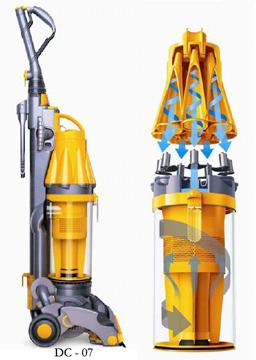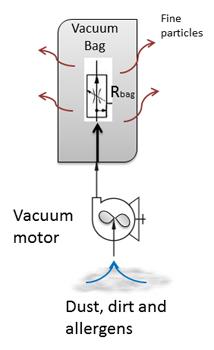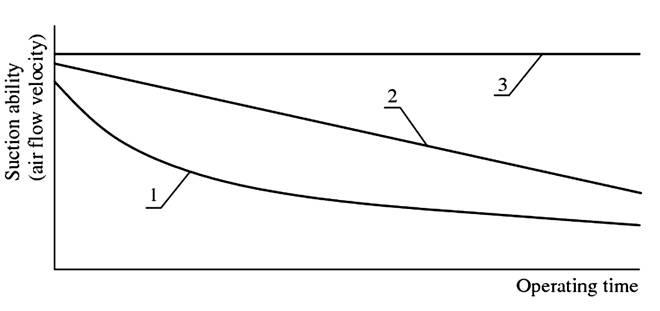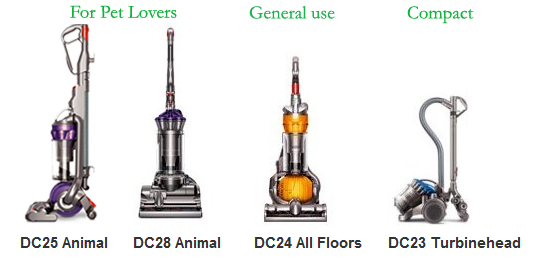Dyson Cleaners - The World's Best Vacuum Cleaner (Part I)

Credit: Amazon.com
The Cult of Dyson
I'm an engineer, and many companies keep their engineers away from the customer because they make the worse salesmen. But when it comes to products they really believe in, try stopping them from rattling off seemingly random facts that demonstrate a product's superiority.There are products that sell and then there are products that inspire and transform. After you've used a Dyson, there is no way you can go back to vacuuming as you used to. I occasionally bust out my napkin sketches and have even loaned out my Dyson (I use the original DC-07) to others I've spoken with.
If you look online, you'll find no shortage of people who simple LOVE their Dyson vacuum cleaners and will give it a 5-star rating without hesitation. The only other product to generate so much love and a near cult following is the Apple brand. People love the Dyson, and they don't just love it, they're fanatical about it. Fanatical enough to go out and tell all their friends about it. Like the Mac, Dysons have generated a lot of controversy and cost considerablymore than their competition. It's interesting that Mac users have adopted a Christian terminology in describing its users:
- Skeptics and Seekers - they view the Mac as an over-priced PC, but are curious
- Mac Convert- someone who goes from a non-believer to a believer
- Mac Follower- they love the Mac and follow the ways of the Mac
- Mac Evangelist- these are usually your super-geeks who are absolutely nuts about apple and their Macs. Their knowledge has given them a platform to share this love with other soon-to-be converts.
The Dyson ... ahh .... generates that same type of love and loyalty. Dyson also has a founder who is considered a genius and a visionary. Owning a Dyson will change your life - especially if you're an allergy sufferer. But like the Mac it does cost about 1.5 - 2x as much as other competitive vacuum cleaners. Here are a few Epinion comment titles about the Dyson:
- "Yes, ... it's another person in love with the Dyson"
- "I was sucked in by the Animal Magnetism"
- "I haven't been this enthusiastic about a product in years."
Can you feel the love? Show me another vacuum cleaner that gets included in the family photos.
Why the Dyson Cleaner is the Best Vacuum Cleaner
I created the diagram below to show how a conventional vacuum cleaner works.

Credit: BananaYellow
A conventional vacuum cleaner works like this: 1) an electric motor draws air into the vacuum 2) this air is forced through a bag with really small holes so that dirt and dust are captured into the bag, but air is forced out. One of the obvious fundamental problems with the conventional vacuum cleaner is that as you use the vacuum cleaner it fills up with dirt; and as it fills up with dirt, the dirt clogs up all the pores of the vacuum bag and restricts air flow (effective flow resistance from the vacuum bag increases). What this means is that if you use your vacuum even just a few times, the vacuum that you're able to generate can drop by by 30-50% with just the first few uses and then drop to a disappointingly low value as you exceed 1/3 to 1/2 of the bag capacity. Remember that the amount of "suction" that a vacuum cleaner generates is related to the air velocity at the vacuum head, and this is dramatically reduced as air flow is limited. The beauty of the Dyson is that there is no bag at all. Below is a graph showing vacuuming ability vs. time (or usage).
1) This first line is for a conventional bag-type vacuum cleaner (some have a higher initial motor power than the Dyson, but it drops sharply after the first few uses).
2) The second line is for a conventional bagless vacuum cleaner. These also rely on a main "cyclone", similar to the Dyson, to remove large dirt particles from the air but rely on a more expensive filter to capture the finer particles.
3) The third line is for the Dyson (and others that have imitated their design). Like the conventional bagless vacuum cleaner, the Dyson uses a main "cyclone" that removes large dirt particles from the air flow; but it is completely different because the second stage is a set of 7 parallel tiny cyclones, each spinning at high speed and forcing tiny dust particles to drop out.

Credit: Dr. Mark D. Krymsky, Dr. Eugene M. Finkel
Here's a short commercial where you can hear from James Dyson himself. The Dyson vacuum cleaner is no only a great concept for engineers and physicist, but one that has gone through extensive design, testing, redesign, and usability studies.
Why you'll love your Dyson
In Europe and most other countries in the world (other than the United States) the Dyson Vacuum cleaner is the top-selling vacuum cleaner. People in the United States are just starting to "see the light" and become passionate converts. If you're looking for a special gift for Mother's Day, Father's Day or Christmas, this may be something to consider for that special someone. Let me just list out why you'll love your Dyson.- If you're an allergy sufferer, there simply isn't another vacuum that will clean quite as well without spending a small fortune on vacuum bags or ejecting allergens into the air.
- Contractors I know refuse to use anything else. Men who like doing home projects will love using your Dyson for cleaning up. Drywall, for example, quickly plugs up traditional vacuum bags; but your Dyson will just suck up all the debris from your cleaning projects.
- Women, wouldn't you love to see the men in your life (husband, brother, boyfriend) fighting for the opportunity to vacuum the home? I loaned my Dyson to one girl, and this really happened. They vacuumed 3 times in a row and filled up the canister each time. The funny thing was that her family was fighting to see who would vacuum next.
- Car lovers will love it because when the Dyson is upright, all the vacuum is diverted to the tube and wand extension. Ok, car lovers may also like the cordless version; but be prepared to be pleasantly surprised by the incredible amount of suction generated. The only danger is that you may pull in a few coins and screws along with all the dust and food crumbs in your car.
Which Dyson should I buy?

If you've heard enough and are ready to go shopping, click on the image above. If you're still thinking about it, then read on. For dog and cat owners, any of the Dyson vacuum cleaners will be a big improvement from what you're using but consider one of the Dyson Animals (see the video below). For general use, the DC24 (the DC25 is the updated equivalent) is probably one of the most popular. Some people with really large homes will prefer the standard version without the ball so I would recommend dropping by a store to try one out if you're not sure. If you live in Japan or in many European countries where space is limited in the home, then you might just fall in love with the DC23 or one of the other models of canister-type Dysons.
The Dyson Animal
I don't own any dogs, cats, or hamsters; but if I did, I would buy this little vacuum in a heartbeat. The Dyson Animal comes with a special motorized brush bar for cleaning animal hairs off furniture. There's a larger version, but the portability of this version is really nice. Dyson also sells a grooming tool for pets.
I should warn you that once you go Dyson, there's no going back. You'll find yourself thoroughly dissatisfied with anything else.
Other Articles You Might Like
- Dyson Cleaners - The World's Best Vacuum Cleaner (Part II)
- Cheapest Vacuum Cleaner - The Economics of Vacuum Cleaners
- 3 Reasons You'll Never See Dyson Vacs On Sale
- Eureka! Let's Eradicate Pet Fur
by Carrie Boyko, CEB Buffer Our #EurekaPower giveaway certainly did garner a lot of interest. It's no great surprise, as this vacuum has won awards at my home too. Did you read my review of this AirSpeed EXACT Pet vacuum? Check it out at the link...
- Reducing Pet Allergens In 10 Easy Steps
By Paris Permenter and John Bigley © MyPetAllergies.com Clean Carpets Means Fewer Allergy SymptomsAs pet lovers, we all know that pet dander and pet hair are a fact of life. To keep our homes tidy, pet parents vacuum and remove those tumbleweeds of fallen...
- Music Therapy For Dogs?
My new pup, "Big Al" By Langley Cornwell We adopted another dog recently. He needed a home quickly so we are making it work, even though our original plan was to wait until we moved into a house with a yard before getting a second dog. One of our biggest...
- 5 Items You Don't Need When You Have A Pet
By Tamara L. Waters A pet can enrich our lives in so many ways, but there’s one way we probably never counted on –saving money. That's right! There are some normal household items you just don't need when you have a pet, so imagine the money...
- Household Cleaners That Aren’t Pet Friendly
By Linda Cole Some days, it's a constant battle trying to keep up with muddy footprints, nose smudges or footprints on the windows, and pet hair on our furniture. However, the household cleaners we use may impact the health of our pets. If you follow...
